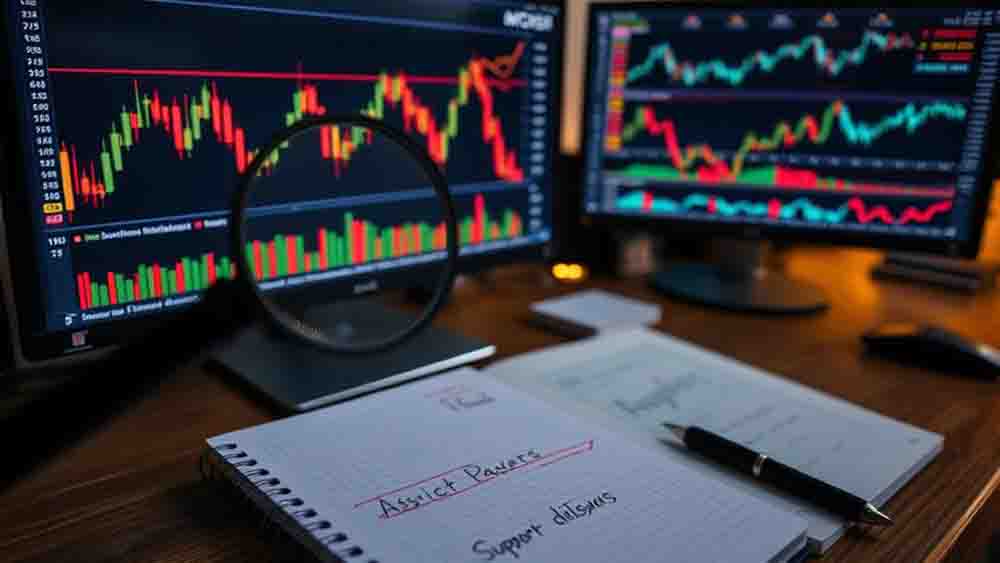Why Start Crypto Day Trading? A Beginner’s Guide
Note: This post may contain affiliate links, and we may earn a commission (with No additional cost for you) if you make a purchase via our link. See our disclosure for more info. The crypto world is constantly changing. This content is for informational purposes only and not financial, legal, or professional advice So, please verify the info on the cryptocurrency provider’s websites.
You've probably heard about the allure of crypto day trading—the potential for quick profits, the thrill of market movements, and the flexibility of a 24/7 market. But before you jump in, it's essential to understand what you're getting into. Crypto day trading isn't just about buying low and selling high; it's a complex dance of strategy, analysis, and risk management. While the rewards can be significant, so too are the risks. Whether you're looking to supplement your income or make a career change, this guide will explore the ins and outs of crypto day trading. Are you ready to discover if it's the right path for you?
Key Takeaways
- Crypto markets operate 24/7, offering continuous trading opportunities and flexibility for traders.
- High volatility in cryptocurrencies creates potential for significant profits in short time frames.
- Advanced tools and platforms make it easier for beginners to enter the market and analyze trends.
- Diversification across multiple cryptocurrencies can help manage risk and maximize opportunities.
- The evolving nature of cryptocurrencies presents ongoing opportunities for traders to capitalize on emerging trends.
Understanding Crypto Market Dynamics
Diving into crypto day trading requires a solid grasp of the market's unique dynamics. Unlike traditional stock markets, crypto markets operate 24/7, offering continuous trading opportunities. This round-the-clock accessibility allows you to capitalize on price movements that happen at any time, day or night.
Market volatility is a defining characteristic of cryptocurrencies. Price fluctuations can be extreme, as evidenced by Bitcoin's significant drops in recent years. For example:
- 73% decline in 2018
- 64% decline in 2022
These dramatic shifts underscore the significance of understanding market sentiment and speculation, which primarily drive crypto prices. Without backing from tangible assets or cash flows, cryptocurrencies are particularly susceptible to rapid value changes.
The crypto landscape is constantly evolving, with new currencies and innovations regularly entering the market. This creates ongoing opportunities for traders to explore and potentially profit from emerging trends.
However, it's essential to remain aware of the developing regulatory environment surrounding cryptocurrencies. The uncertain legal landscape can impact market stability and trading practices, adding an extra layer of complexity to your decision-making process.

Essential Tools for Day Trading
To succeed in crypto day trading, you'll need a robust toolkit at your disposal. First and foremost, choose reputable trading platforms like Binance or Coinbase, which offer user-friendly interfaces and low fees. These platforms provide a secure environment for executing trades efficiently.
Incorporate advanced charting software, such as TradingView, to analyze price trends and patterns. This tool will help you make informed decisions based on technical analysis. Additionally, utilize essential technical indicators like MACD and RSI to identify potential entry and exit points in your trades.
Access to real-time data feeds is vital for staying updated on price movements and significant events that could impact market sentiment. This information will allow you to adjust your trading strategies quickly and effectively.
To enhance your trading capabilities, leverage mobile trading apps. These applications enable you to trade on-the-go, executing trades and monitoring your portfolio in real-time, regardless of your location.
Risk Management Strategies
Effective risk management is the cornerstone of successful crypto day trading. As you navigate the volatile world of cryptocurrencies, implementing robust risk management strategies can protect your capital and improve your long-term profitability.
One essential technique is the use of stop-loss orders, which automatically close your positions at predetermined levels, limiting potential losses. Position sizing is another significant aspect; you should only risk a small percentage (1-2%) of your total capital on any single trade to safeguard against substantial losses.
Diversification is key to reducing overall portfolio risk. By spreading your investments across multiple cryptocurrencies, you'll mitigate the impact of adverse price movements in any single asset.
Regular review and adjustment of your trading strategies based on performance and market conditions will help you stay adaptable in the ever-changing crypto landscape.
Emotional discipline plays an important role in risk management. Avoid making impulsive decisions driven by fear or greed, as these can lead to poor trading outcomes.
Instead, stick to your predetermined strategy and risk parameters. By implementing these risk management techniques, you'll be better equipped to navigate the challenges of crypto day trading and increase your chances of long-term success.

Developing a Trading Plan
Building on the foundation of sound risk management, a well-crafted trading plan serves as your roadmap to success in crypto day trading. Your plan should clearly define your goals, including specific profit targets and acceptable loss limits. This framework will guide your decision-making during volatile market conditions, helping you stay focused on your objectives.
Incorporate risk management strategies into your plan, such as position sizing and stop-loss orders, to protect against potential losses in the unpredictable cryptocurrency market. Regularly review and adjust your plan based on performance and changing market dynamics to guarantee it remains effective and aligned with your goals.
| Component | Purpose | Example |
|---|---|---|
| Goals | Define targets | 2% daily profit |
| Risk Management | Protect capital | 1% max loss per trade |
| Strategy | Guide decisions | Moving average crossover |
| Review Process | Improve performance | Weekly analysis |
Utilize backtesting techniques to evaluate your trading strategies against historical data, enhancing your understanding of what works best in different market scenarios. Document your trades and decisions in a trading journal to identify patterns in your behavior, helping you refine your approach and improve future trading outcomes. By developing an extensive trading plan that addresses profits and losses, risk management strategies, and continuous improvement, you'll be better equipped to navigate the challenges of crypto day trading.
Technical Analysis Fundamentals
To master technical analysis fundamentals, you'll need to understand chart patterns, indicators, and oscillators.
Chart patterns, like head and shoulders or double bottoms, can help you identify potential trend reversals or continuations in cryptocurrency prices.
Indicators and oscillators, such as moving averages, MACD, and RSI, provide valuable insights into market momentum and potential overbought or oversold conditions.
Chart Patterns Explained
When you're diving into crypto day trading, understanding chart patterns is essential for making informed decisions. These graphical representations of price movements over time help you identify potential trend reversals and continuations by analyzing historical data.
Common chart patterns include head and shoulders, double tops and bottoms, and triangles, each indicating specific market sentiment and potential future price movements.
For example, the head and shoulders pattern signals a reversal from bullish to bearish, while its inverse suggests a bullish reversal. Flags and pennants, on the other hand, represent continuation signals, indicating that the price will likely continue in the direction of the prevailing trend after a brief consolidation period.
To enhance your analysis, you can complement chart patterns with technical indicators like the Moving Average Convergence Divergence (MACD) and Relative Strength Index (RSI). These tools provide additional insights into market momentum and potential overbought or oversold conditions.
By mastering chart pattern recognition and combining it with technical indicators, you'll be better equipped to:
- Identify potential entry and exit points
- Gauge market sentiment
- Make more informed trading decisions

Indicators and Oscillators
How can you gain deeper insights into market trends and potential reversals? The answer lies in mastering indicators and oscillators, essential tools in technical analysis for crypto day trading. These powerful instruments analyze historical price data to help you make informed decisions.
Key indicators to incorporate into your trading strategies include:
- Moving Average (MA): Smooths price data to identify trends
- Relative Strength Index (RSI): Measures price momentum and indicates overbought or oversold conditions
- Moving Average Convergence Divergence (MACD): Compares two moving averages to determine momentum and potential buy/sell signals
Additionally, volume indicators like On-Balance Volume (OBV) provide insights into the strength of price trends by evaluating the relationship between volume and price changes.
By understanding how to interpret these indicators and oscillators, you'll enhance your ability to spot potential market opportunities and risks. For example, when the RSI approaches 70, it may suggest an overbought condition, while readings near 30 could indicate oversold conditions.
Similarly, when the MACD line crosses above the signal line, it might generate a bullish signal.
Incorporating these tools into your crypto day trading strategy can considerably improve your decision-making process and potentially increase your chances of success in the volatile cryptocurrency market.
Choosing the Right Exchange
Selecting the right cryptocurrency exchange is a vital step in your day trading journey. When evaluating platforms, prioritize those with low trading fees, as these can greatly impact your profits, especially if you're making frequent trades.
High liquidity is another essential factor to take into account, as it enables quicker transactions and reduces slippage, allowing you to execute trades at your desired prices.
Security measures should be a top priority when choosing an exchange. Look for platforms that offer robust protection, such as two-factor authentication and cold storage for funds. These features help safeguard your assets against potential hacks and breaches.
Reflect on the following additional factors when selecting an exchange:
- User interface and trading tools: A user-friendly platform with advanced charting and analytical features can enhance your trading experience.
- Regulatory compliance: Choose exchanges that adhere to local regulations to guarantee your trading activities are legal and your funds are protected.
- Supported cryptocurrencies: Verify that the exchange offers the specific coins you wish to trade.
- Customer support: Opt for platforms with responsive and knowledgeable support teams to assist you when needed.
Psychological Aspects of Trading
As you explore crypto day trading, mastering the psychological aspects of trading becomes just as essential as understanding market dynamics.
Emotional control plays a vital role in your success, as impulsive decisions driven by fear or greed can lead to significant losses in the volatile crypto market. To maintain a disciplined approach, set predefined trading strategies and stick to them, even during rapid price fluctuations.
To improve your psychological preparedness for trading, consider:
- Keeping a trading journal to identify behavioral patterns
- Practicing mindfulness techniques to enhance focus and reduce stress
- Staying informed about broader market trends and news to understand market sentiment

Tax Implications for Traders
As a crypto day trader, you need to be aware of the tax implications of your activities.
You'll likely encounter capital gains taxes on your profits, which require careful reporting of your transactions to the IRS.
To minimize your tax burden, you can explore strategies like tax-loss harvesting, which allows you to offset gains with losses from your trading activities.
Capital Gains Tax Basics
Crypto traders must navigate the complex world of capital gains taxes to stay compliant with IRS regulations. When you sell or trade cryptocurrencies, you're required to report your gains and losses on Form 1099. The IRS treats cryptocurrencies as property, subjecting them to capital gains tax rules. Understanding these basics is essential for effective tax planning and avoiding potential penalties.
Short-term capital gains, resulting from assets held for less than a year, are taxed at your ordinary income rate, which can be as high as 37%. However, long-term capital gains, applicable to assets held for over a year, benefit from lower tax rates ranging from 0% to 20%.
To minimize your tax liability, consider implementing tax-loss harvesting strategies by selling losing positions to offset gains.
Key points to remember:
- Capital gains tax applies to profits from cryptocurrency trading
- Short-term gains are taxed at higher rates than long-term gains
- Tax-loss harvesting can help reduce your overall tax burden
Unlike traditional securities, cryptocurrencies aren't subject to wash sale rules, allowing you to claim losses even if you repurchase the same asset shortly after selling.
This unique aspect provides additional flexibility in managing your tax obligations while actively trading cryptocurrencies.
Reporting Crypto Transactions
Compliance with tax regulations is an essential aspect of cryptocurrency trading that often catches traders off guard. As a crypto day trader, you're responsible for reporting crypto transactions to the IRS, especially when they exceed $600 in a calendar year. This reporting is typically done through Form 1099, which documents your capital gains or losses.
Understanding the tax implications of your trading activities is important:
- Short-term capital gains from assets held for less than a year are taxed at ordinary income rates, which can be considerably higher than long-term rates.
- As of 2023, the absence of wash sale rules for cryptocurrencies allows you to claim losses even if you repurchase the same asset shortly after selling.
- Tax-loss harvesting can be used to offset gains with losses, potentially reducing your overall tax liability.
It's significant to note that cryptocurrency tax regulations vary by jurisdiction. To guarantee compliance with local laws and optimize your tax strategy, consult with a tax professional familiar with crypto taxation.
Keeping detailed records of all your transactions will help you accurately report your trading activities and avoid potential issues with tax authorities.
Tax-Loss Harvesting Strategies
While day trading cryptocurrencies can be exhilarating, it's vital to understand tax-loss harvesting strategies to optimize your tax position. Tax-loss harvesting involves selling cryptocurrencies at a loss to offset capital gains taxes, potentially lowering your overall tax liability for the year. This strategy is particularly useful for crypto traders, as the IRS doesn't apply wash sale rules to cryptocurrencies, allowing you to claim losses even if you repurchase the same asset shortly after selling.
To effectively implement tax-loss harvesting:
- Track all your cryptocurrency transactions meticulously
- Identify underperforming assets to sell at a loss
- Time your sales strategically, especially towards year-end
Short-term capital gains from crypto trading are taxed at ordinary income rates, which can be markedly higher than long-term rates. By utilizing tax-loss harvesting, you can offset these gains and potentially reduce your tax burden.
Learning From Experienced Traders
In light of the crypto market's volatility, learning from experienced traders is vital for day trading success. Seasoned traders emphasize the importance of developing a clear trading strategy with defined goals, which can help you navigate the unpredictable crypto landscape effectively.
By adopting strategies from experienced traders, you'll be better equipped to make informed decisions and manage risks.
To enhance your learning process:
- Maintain a trading journal to track trades and emotional responses
- Utilize technical analysis tools, such as support and resistance levels
- Start with small investments to practice risk management
- Join trading communities and forums for real-time insights
Experienced traders often recommend keeping a detailed record of your trades and emotional reactions. This practice allows you to identify patterns and improve your decision-making over time.
Additionally, learning to use technical analysis tools can greatly enhance your trade timing and overall performance.
As you begin your crypto day trading journey, it's important to start small and gradually increase your investments as you gain experience. This approach allows you to learn without risking substantial financial losses.
Frequently Asked Questions
Can You Make a Day With Crypto?
Yes, you can potentially make $100 a day with crypto trading. The market's high volatility offers opportunities to profit from price movements.
By using strategies like scalping or momentum trading, you can capitalize on rapid changes. The 24/7 nature of crypto markets allows for multiple trades daily, increasing your chances of reaching your goal.
However, it's essential to employ effective risk management techniques, such as stop-loss orders, and maintain a disciplined approach to consistently achieve this target in the unpredictable crypto landscape.
How to Start Crypto Trading as a Beginner?
Did you know that 86% of cryptocurrency traders are under 45?
To start crypto trading as a beginner, you'll want to:
- Choose a user-friendly exchange like Coinbase or Binance
- Learn essential trading terminology and strategies
- Start with a small investment to manage risk
- Practice using demo accounts
- Stay informed about market trends
These steps will help you navigate the volatile crypto market.
What Is the Best Crypto to Start Day Trading?
When starting day trading in cryptocurrencies, you'll want to take into account established options like Bitcoin (BTC) and Ethereum (ETH). These offer high liquidity and substantial trading volumes, making them ideal for beginners.
You might also explore altcoins such as Binance Coin (BNB) or Cardano (ADA) for their volatility and potential gains. It's essential to focus on cryptocurrencies with daily trading volumes exceeding $1 million to guarantee market stability.
Additionally, trading pairs with stablecoins like USDT can help minimize your exposure to volatility while you learn.
Should I Start Crypto Trading?
Picture yourself riding a digital wave of opportunity, as you contemplate entering the world of crypto trading.
You should start crypto trading if you're prepared to invest time in learning market dynamics and developing a solid strategy. It's a high-risk, high-reward endeavor that requires discipline and emotional control.
Consider your financial situation, risk tolerance, and time commitment. Start with a small investment and practice with demo accounts.
Conclusion
As you commence your crypto day trading journey, remember that success isn't guaranteed. Like tending a garden, you'll need patience, dedication, and a willingness to learn from both failures and successes. Start small, stay informed, and continuously refine your strategies. By implementing the tools and techniques discussed, you'll be better equipped to navigate the volatile crypto markets. With time and practice, you'll develop the skills needed to potentially reap the rewards of this dynamic trading environment.











